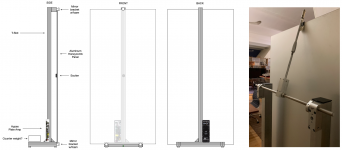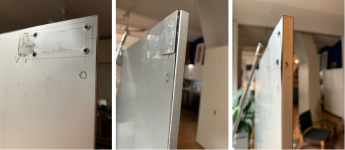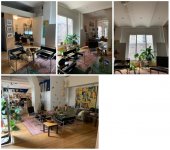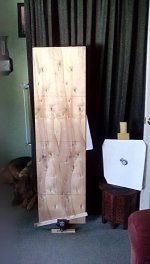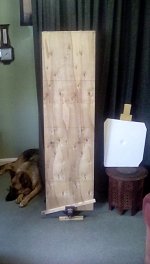Nice work AAGAS! Very cool to get a postive and astonished reaction out of spouse like that. Maybe you built up your credibility a few notches! I was going to say your home is very neat and modern, decorated as if done by an architect. LOL.
I missed what you said your panels were made of? Interesting way to suspend them - is ti single point hinge?
I missed what you said your panels were made of? Interesting way to suspend them - is ti single point hinge?
xrk971
Aluminum honeycomb panels found on the steet across from my loft in NYC.
See hinge/frame close up in the attached. The frame a bit jerry-rigged and the whole probably vulnerable to getting knocked over at this point.
I had all the hardware pieces sitting around my storage room.
The attached photo has my latest thoughts on on a more permanent and secure frame for the panels.
What I currently hear from the panels has me thinking that the weight of the panels on the inverted speaker spikes may have some positive affect on the sound.
Still forming my thoughts.
I missed what you said your panels were made of? Interesting way to suspend them - is ti single point hinge?
Aluminum honeycomb panels found on the steet across from my loft in NYC.
See hinge/frame close up in the attached. The frame a bit jerry-rigged and the whole probably vulnerable to getting knocked over at this point.
I had all the hardware pieces sitting around my storage room.
The attached photo has my latest thoughts on on a more permanent and secure frame for the panels.
What I currently hear from the panels has me thinking that the weight of the panels on the inverted speaker spikes may have some positive affect on the sound.
Still forming my thoughts.
Attachments
Last edited:
One possible issue with large aluminum honeycomb panels.
My business has me on the phone much of the work day. I typically walk around my loft during these calls and get in steps. I can regularly get in 10,000 step without leaving the house. Not bad in a COVID plagued world.
Today, every time I walked pass the aluminum panels, I lost my cell phone connection.
At first I thought, ATT, snowing in NY, lousy connection. Over the day I finally figured out that walking by the panels blocked and then lost the cell signal.
Hmmm....?
Unintended consequences, but I'll take the trade ;-)
My business has me on the phone much of the work day. I typically walk around my loft during these calls and get in steps. I can regularly get in 10,000 step without leaving the house. Not bad in a COVID plagued world.
Today, every time I walked pass the aluminum panels, I lost my cell phone connection.
At first I thought, ATT, snowing in NY, lousy connection. Over the day I finally figured out that walking by the panels blocked and then lost the cell signal.
Hmmm....?
Unintended consequences, but I'll take the trade ;-)
KoAp
Sorry.
Just spotted the tweeter goes from 5k to 20k,no measurements though.
From what I could make out they use the same material as the woofer section.
I'm wondering if he used the old quads as a template for the two panels either side of a thin tweeter?
Steve
Sorry.
Just spotted the tweeter goes from 5k to 20k,no measurements though.
From what I could make out they use the same material as the woofer section.
I'm wondering if he used the old quads as a template for the two panels either side of a thin tweeter?
Steve
Weird. Oh well, here it isThe post was not by AAGAS, but I see reference to 1/2in thick XPS foam?
I recently found 2 aluminum honey comb panels on the street in Manhattan.
70 3/4" x 28 1/4" x 1/4"
The came from a high-end kitchen store.
They have a beautiful satin finish, probably some kind of polymer on the aluminum.
They additionally appear to have an internal frame around the edge.
Light weight. Very rigid...
The moving magnet is good at low frequencies, and at high frequencies I would use a moving coil, maybe even with two coils.KoAp
Sorry.
Just spotted the tweeter goes from 5k to 20k,no measurements though.
Steve
KoAP.
Although I did toy with the idea of using a bass shaker (some go up to about 10k or so)with a small tweeter panel.
But as even the small tweeters that i was making were getting so close to ,or below the 300HZ that I normally run my low frequency drivers up to, in the end it just seemed a bit pointless.
I'm not sure what size my large eps panels will be in the end ,but I will probably roll them off at about 100hz,no matter what.
The tweet panels (if you can call them that)will probably be rolled off at the same frequency?
Allowing me to switch between them or running together, the best of both worlds, as you might say.
Steve.
Although I did toy with the idea of using a bass shaker (some go up to about 10k or so)with a small tweeter panel.
But as even the small tweeters that i was making were getting so close to ,or below the 300HZ that I normally run my low frequency drivers up to, in the end it just seemed a bit pointless.
I'm not sure what size my large eps panels will be in the end ,but I will probably roll them off at about 100hz,no matter what.
The tweet panels (if you can call them that)will probably be rolled off at the same frequency?
Allowing me to switch between them or running together, the best of both worlds, as you might say.
Steve.
One week in
I set up my panels one week ago. They have so engaged and seduced me that I haven't done any measurements yet. I just want to listen to music through them.
That said, I thought to share some early: impressions (if subjective) and conjectures about this technology.
2 changes (so far)
I've only made 2 small changes since my first reports on the speaker last weekend.
I've bridged the two main channels on the Hypex FA123s. Essentially, I drive the speakers with a pair of 250 watt (into the 4 Ohm exciters) mono amps. No crossover. No equalization yet.
I have attenuated the right channel just bit. I've needed to do this with all speakers I've placed in the same general position -- something odd about room reflections (see photos). We have a very open plan loft in an old industrial building and the living/listening area opens up more to one side than the other. One would think I'd need to boost that channel. Any thoughts appreciated.
Otherwise, nothing else. I haven't even moved the speakers from where I first set them.
Listening space.
High ceilings, 12'. Massive concrete and masonry construction. Floors 8" concrete (with oak floors on top). Exterior walls, 1' thick brick with 2' thick pilasters of steel encased brick every 15'. Ceilings 8" concrete supported by plastered brick arches caught by steel beams.
My listening area: 23' front to back x ~20' side to side x 12' high. As stated before, the space opens up more to the right as I face the speakers.
You can see from the attached pictures of the space that the arches in the ceiling present the worst physical attribute of the space. Anything reflecting off of that ceiling gets focused.
In the past I have had the most success with speaker systems that didn't have much vertical dispersion (ribbons, panels, electrostatics).
Not fully clear yet how the DMLs interact with the ceiling. Thoughts appreciated.
Aluminum honeycomb panels
The fronts of the honeycomb panels look beautiful. On the other hand, I got these when the kitchen store I mentioned wanted to throw them into a dumpster.
See close ups of two of the rear corners of the panels attached. The panels have some old screws holes in them, a couple of places near a couple of corners have started to delaminate.
The panels have square corners.
Nothing perfect about these panels.
Impressions so far
Giving the speakers more power, just made them sound even better, which I didn't really think possible.
Everything I reported last week, just more so.
I have an eighty year old friend, brilliant guy, sharp as ever. Small, fit, wiry. I sat him down on the couch and played the speakers.
He couldn't stay in the seat.
At first he kept getting up and walking back and forth parallel to the speakers. He commented that the speakers sounded great from anywhere in the room. I had the same experience. These speakers seem to defy the notion of a sweet spot.
When, he started listening more intently to each track, he'd start seated, then spring to his feet, and start dancing. He either has some "soft shoe" history I don't know about, or he had channeled Bill "Bojangles" Robinson.
_____________________
Conjectures & speculation
How do these particular speakers (mostly assembled from found and old parts and with damage to the panels) sound so good?
Size & rigidity matter most
I think size and rigidity of the panels overcome everything else.
These panels weigh 13 lbs each.
One might get a better rigidity to weight ratio with titanium honeycomb panels, but I don't think much else beats the aluminum with an aluminum honeycomb core.
Conjecture -because the size of these panels (at 70.75" x 28.25") far exceeds the area of the parts of the panels that have damage or would produce "corner" distortion, the volume of the good quality sound produced so exceeds the volume of what the damaged and distorting parts produce that the bad sound and/or distortion effectively disappear?
Rigidity to weight ratio to area of the panel matters
With a sufficient rigidity to weight ratio and enough area one won't need multiple exciters per panel. The panel just does everything.
Voices, breath, ... they just do everything.
Suspension matters
At this point, I've got a pretty dodgy suspension system. Each panel precariously balances on a pair of upside down speaker spikes and held at the top with a binder clip and a bit of old acoustic foam.
I mentioned this in a previous post... I wonder if the weight of the panel on those speaker spikes, does something to stabilize the panel. This doesn't even rise to the level of a conjecture. Just grasping for an explanation.
I do need to develop a more secure supporting frame and suspension system, so someone banging the speakers with a vacuum cleaner or trying to adjust their position in the room doesn't have them tumbling down into pieces.
Suggestions appreciate.
Exciter placement
One exciter dead center on the back of the panel. It seems to work. I'd happily consider other placement, but certainly don't have a subjective reason to do so.
Thoughts appreciated.
Next steps
If I can put off the joy of listening to these things, I'll try to do some measurements.
I've got:
I've always relied on the kindness of friends to do this sort of thing. COVID has me on my own.
Suggestions regarding what else I need and how to go about producing meaningful measurements appreciated.
I set up my panels one week ago. They have so engaged and seduced me that I haven't done any measurements yet. I just want to listen to music through them.
That said, I thought to share some early: impressions (if subjective) and conjectures about this technology.
2 changes (so far)
I've only made 2 small changes since my first reports on the speaker last weekend.
I've bridged the two main channels on the Hypex FA123s. Essentially, I drive the speakers with a pair of 250 watt (into the 4 Ohm exciters) mono amps. No crossover. No equalization yet.
I have attenuated the right channel just bit. I've needed to do this with all speakers I've placed in the same general position -- something odd about room reflections (see photos). We have a very open plan loft in an old industrial building and the living/listening area opens up more to one side than the other. One would think I'd need to boost that channel. Any thoughts appreciated.
Otherwise, nothing else. I haven't even moved the speakers from where I first set them.
Listening space.
High ceilings, 12'. Massive concrete and masonry construction. Floors 8" concrete (with oak floors on top). Exterior walls, 1' thick brick with 2' thick pilasters of steel encased brick every 15'. Ceilings 8" concrete supported by plastered brick arches caught by steel beams.
My listening area: 23' front to back x ~20' side to side x 12' high. As stated before, the space opens up more to the right as I face the speakers.
You can see from the attached pictures of the space that the arches in the ceiling present the worst physical attribute of the space. Anything reflecting off of that ceiling gets focused.
In the past I have had the most success with speaker systems that didn't have much vertical dispersion (ribbons, panels, electrostatics).
Not fully clear yet how the DMLs interact with the ceiling. Thoughts appreciated.
Aluminum honeycomb panels
The fronts of the honeycomb panels look beautiful. On the other hand, I got these when the kitchen store I mentioned wanted to throw them into a dumpster.
See close ups of two of the rear corners of the panels attached. The panels have some old screws holes in them, a couple of places near a couple of corners have started to delaminate.
The panels have square corners.
Nothing perfect about these panels.
Impressions so far
Giving the speakers more power, just made them sound even better, which I didn't really think possible.
Everything I reported last week, just more so.
I have an eighty year old friend, brilliant guy, sharp as ever. Small, fit, wiry. I sat him down on the couch and played the speakers.
He couldn't stay in the seat.
At first he kept getting up and walking back and forth parallel to the speakers. He commented that the speakers sounded great from anywhere in the room. I had the same experience. These speakers seem to defy the notion of a sweet spot.
When, he started listening more intently to each track, he'd start seated, then spring to his feet, and start dancing. He either has some "soft shoe" history I don't know about, or he had channeled Bill "Bojangles" Robinson.
_____________________
Conjectures & speculation
How do these particular speakers (mostly assembled from found and old parts and with damage to the panels) sound so good?
Size & rigidity matter most
I think size and rigidity of the panels overcome everything else.
These panels weigh 13 lbs each.
One might get a better rigidity to weight ratio with titanium honeycomb panels, but I don't think much else beats the aluminum with an aluminum honeycomb core.
Conjecture -because the size of these panels (at 70.75" x 28.25") far exceeds the area of the parts of the panels that have damage or would produce "corner" distortion, the volume of the good quality sound produced so exceeds the volume of what the damaged and distorting parts produce that the bad sound and/or distortion effectively disappear?
Rigidity to weight ratio to area of the panel matters
With a sufficient rigidity to weight ratio and enough area one won't need multiple exciters per panel. The panel just does everything.
Volume sufficient to give you the experience of sitting in the front row of a rock concert.
More bass than I thought my listening room could produce.
Effortless mid range.
Highs that I didn't think my old ears could hear anymore.
More bass than I thought my listening room could produce.
Effortless mid range.
Highs that I didn't think my old ears could hear anymore.
Voices, breath, ... they just do everything.
Suspension matters
At this point, I've got a pretty dodgy suspension system. Each panel precariously balances on a pair of upside down speaker spikes and held at the top with a binder clip and a bit of old acoustic foam.
I mentioned this in a previous post... I wonder if the weight of the panel on those speaker spikes, does something to stabilize the panel. This doesn't even rise to the level of a conjecture. Just grasping for an explanation.
I do need to develop a more secure supporting frame and suspension system, so someone banging the speakers with a vacuum cleaner or trying to adjust their position in the room doesn't have them tumbling down into pieces.
Suggestions appreciate.
Exciter placement
One exciter dead center on the back of the panel. It seems to work. I'd happily consider other placement, but certainly don't have a subjective reason to do so.
Thoughts appreciated.
Next steps
If I can put off the joy of listening to these things, I'll try to do some measurements.
I've got:
Beheringer U-Phoria UMC22
Beheringer ECM8000
Cable
Microphone stand
Beheringer ECM8000
Cable
Microphone stand
I've always relied on the kindness of friends to do this sort of thing. COVID has me on my own.
Suggestions regarding what else I need and how to go about producing meaningful measurements appreciated.
Attachments
Last edited:
chdsl,
Yes.
Mine = 3/8" thick. Likely produced for the US market.
Closest to the 10 mm on the link you provided.
My panels additionally have an aluminum edge that appears heavier than the skins of the panels.
I've actually wondered whether that additional rigidity at the edge beneficially affects the sound.
My panels have a clear coating of some kind (which resists finger prints). Not certain if it would affect the sound.
It has occurred to me that one could get the surface of such panels anodized in any color.
One could get the surface of such panels printed with photographs.
Lot's of possible fun;-)
Not certain of the weight/thickness of the skins on my vis-a-vis those on your link.
Are the Aluminium panels something like this?
Yes.
Mine = 3/8" thick. Likely produced for the US market.
Closest to the 10 mm on the link you provided.
My panels additionally have an aluminum edge that appears heavier than the skins of the panels.
I've actually wondered whether that additional rigidity at the edge beneficially affects the sound.
My panels have a clear coating of some kind (which resists finger prints). Not certain if it would affect the sound.
It has occurred to me that one could get the surface of such panels anodized in any color.
One could get the surface of such panels printed with photographs.
Lot's of possible fun;-)
Not certain of the weight/thickness of the skins on my vis-a-vis those on your link.
Thanks.
They are sold from 3mm thickness up. They are used internally and externally. Can you post an audio file from your panels? You can record them from a mobile phone too.
They are sold from 3mm thickness up. They are used internally and externally. Can you post an audio file from your panels? You can record them from a mobile phone too.
One week in
Suggestions appreciate.
Aagas,
Thanks for sharing your impressions. You've turned your find into something really cool. Glad to hear you are enjoying them so much. It is too bad that they are not aesthetically perfect, but I'd kind of look at it as battle scars to be proud of instead of imperfections!
Regarding making measurements. what you need to do is download REW (Room EQ Wizard) and learn how to use it.
Concerning how to support them, I have a suggestion but probably it's not exactly what you are looking for. I suggest you build a frame and attach the panel to the frame around much of its perimeter something like I did here:
https://www.diyaudio.com/forums/full-range/272576-study-dmls-range-speaker-85.html#post5978276
This type of support wasn't my idea. I copied it from Tectonics (as well as I could anyway) from the concept shown in this video (at about 1:30 into the video).
The Tectonic DML Part 2 - YouTube
This type of support tends to boost the and flatten the low frequency end IME. Then have The Architect design the supports for the frames!
I wouldn't sweat the square corners. I think the rounded corners thing is myth. Note also that the Tectonics DML shown in the video has square corners, so you are in good company.
Regarding exciter location: Generally dead center is not considered the best location. Slightly off center along both axis is better (in theory at least) because you can excite more bending modes with off center placement. The Azima NXT patents suggest choosing locations that are 4/9, 3/7, or 5/13 along each of the axes. Try one or more of these combinations and see if you can measure or hear any difference from the center location. I suspect you won't hear a difference but will measure one.
Eric
Aagas,
And, oh yeah, consider trying one or two other exciters. They are pretty inexpensive, so it's not a big deal to try a few.
I liked the Ultra (Dayton Audio DAEX32U-4 Ultra 32mm Exciter 20W 4 Ohm) better than the Thruster on most panels. It has a lower power rating but I don't think that will make much if any difference. Also, like the Thruster it has a wide base and low profile so you should be able to get away without adding a spine to support it if you don't want too.
I also like the Dayton Audio DAEX25FHE-4 Framed High Efficiency 25mm Exciter 24W 4 Ohm. But this one is "top heavy" and really needs a spine to support it.
Eric
And, oh yeah, consider trying one or two other exciters. They are pretty inexpensive, so it's not a big deal to try a few.
I liked the Ultra (Dayton Audio DAEX32U-4 Ultra 32mm Exciter 20W 4 Ohm) better than the Thruster on most panels. It has a lower power rating but I don't think that will make much if any difference. Also, like the Thruster it has a wide base and low profile so you should be able to get away without adding a spine to support it if you don't want too.
I also like the Dayton Audio DAEX25FHE-4 Framed High Efficiency 25mm Exciter 24W 4 Ohm. But this one is "top heavy" and really needs a spine to support it.
Eric
Aagas,
Concerning how to support them, I have a suggestion but probably it's not exactly what you are looking for. I suggest you build a frame and attach the panel to the frame around much of its perimeter something like I did here:
https://www.diyaudio.com/forums/full-range/272576-study-dmls-range-speaker-85.html#post5978276
Eric
A lightweight aluminium frame can be made using the kits for fly screen doors like these sold in most hardware stores.
Well, after what seems like a long absence, I have finally got my DML / OB bass hybrid tuned more or less satisfactorily.
Quick system summary:
Sources: Modified Thorens TD166 with AT110E; Creek CD50mk2 CD; PC running JRiver; Topping E30 DAC.
The Rest: FX Audio mini tube preamp; MiniDSP 2x4; 2 x TDA7498E in monobloc configuration; Cabling: Lapp Kabel Olflex 110 mains; Interconnects - home brewed Mogami 2549 pseudo balanced & Klotz MC5000 pseudo balanced. No speaker cables, unless you count the 10 inches from the amp to the speaker binding posts.
Speakers: Home brewed DML / OB bass hybrid - 3mm poplar ply 600 x 400mm rounded corners DML operating from 400hz upwards; 1 x Monacor SP-382PA 15 inch bass driver per side operating to 400hz; Active crossover via miniDSP @ 400hz 24db/octave LR.
All measurements with UMIK-1 into REW.
Bottom line: using the miniDSP parametric equaliser, it's essentially flat from 36hz to 11khz and about 6db down by 20khz. I could add more EQ above 11khz if I had more EQ capability. However, the miniDSP is limited to 5 parametric EQ channels per speaker on input and a further 5 channels per driver and I've run out! The MiniDSP 2x4 HQ would fit the bill as it has double the EQ channels.
It gives the lie to the claim that you cannot get good bass out of an OB bass system. It will play the bottom E (41hz) on a bass with no difficulty. It just needs that bit of extra air at the top end.
Quick system summary:
Sources: Modified Thorens TD166 with AT110E; Creek CD50mk2 CD; PC running JRiver; Topping E30 DAC.
The Rest: FX Audio mini tube preamp; MiniDSP 2x4; 2 x TDA7498E in monobloc configuration; Cabling: Lapp Kabel Olflex 110 mains; Interconnects - home brewed Mogami 2549 pseudo balanced & Klotz MC5000 pseudo balanced. No speaker cables, unless you count the 10 inches from the amp to the speaker binding posts.
Speakers: Home brewed DML / OB bass hybrid - 3mm poplar ply 600 x 400mm rounded corners DML operating from 400hz upwards; 1 x Monacor SP-382PA 15 inch bass driver per side operating to 400hz; Active crossover via miniDSP @ 400hz 24db/octave LR.
All measurements with UMIK-1 into REW.
Bottom line: using the miniDSP parametric equaliser, it's essentially flat from 36hz to 11khz and about 6db down by 20khz. I could add more EQ above 11khz if I had more EQ capability. However, the miniDSP is limited to 5 parametric EQ channels per speaker on input and a further 5 channels per driver and I've run out! The MiniDSP 2x4 HQ would fit the bill as it has double the EQ channels.
It gives the lie to the claim that you cannot get good bass out of an OB bass system. It will play the bottom E (41hz) on a bass with no difficulty. It just needs that bit of extra air at the top end.
aagas.
This is a quick mock up of what I have done in the past,feel free to take some ideas.
If you would like to keep the clean lines of your panels you could build a clamping stand ,I'm sure you can build something better than my vice,which was used for testing.
I did use g clamps as well sometimes.
I've used this with eps and ply.
If you angle the the wood clamp at the bottom,this helps break up standing waves ,if you wish?
In the first photo you will see I cut a piece of card to show how I extended the side a little with an off cut to extend frequency response and offset the exciter ,which as you can see was also at an angle.
The small eps panel on the right was included to show how to convert a square panel into a panel with non parallel sides,without loss of any material.
I just cut off the left side at an angle and glued it to the bottom,that simple.I
You could use a v shape at the bottom or an inverted v ,whichever looks good to you,as long as it breaks up the standing waves from top to bottom.
With enough weight at the bottom it should be stable,and not blow over.
I'm being called!.
So must go!
Steve
This is a quick mock up of what I have done in the past,feel free to take some ideas.
If you would like to keep the clean lines of your panels you could build a clamping stand ,I'm sure you can build something better than my vice,which was used for testing.
I did use g clamps as well sometimes.
I've used this with eps and ply.
If you angle the the wood clamp at the bottom,this helps break up standing waves ,if you wish?
In the first photo you will see I cut a piece of card to show how I extended the side a little with an off cut to extend frequency response and offset the exciter ,which as you can see was also at an angle.
The small eps panel on the right was included to show how to convert a square panel into a panel with non parallel sides,without loss of any material.
I just cut off the left side at an angle and glued it to the bottom,that simple.I
You could use a v shape at the bottom or an inverted v ,whichever looks good to you,as long as it breaks up the standing waves from top to bottom.
With enough weight at the bottom it should be stable,and not blow over.
I'm being called!.
So must go!
Steve
Attachments
Speakers: Home brewed DML / OB bass hybrid - 3mm poplar ply 600 x 400mm rounded corners DML operating from 400hz upwards; 1 x Monacor SP-382PA 15 inch bass driver per side operating to 400hz; Active crossover via miniDSP @ 400hz 24db/octave LR.
Sounds great. I think a WAW system like this is perfect for DMLs. I run mine with a sub too. But you forgot to tell us (or remind us) which exciters you used, how many, placed where, and how the panels are supported, damped, etc.
Thanks,
Eric
- Home
- Loudspeakers
- Full Range
- A Study of DMLs as a Full Range Speaker
